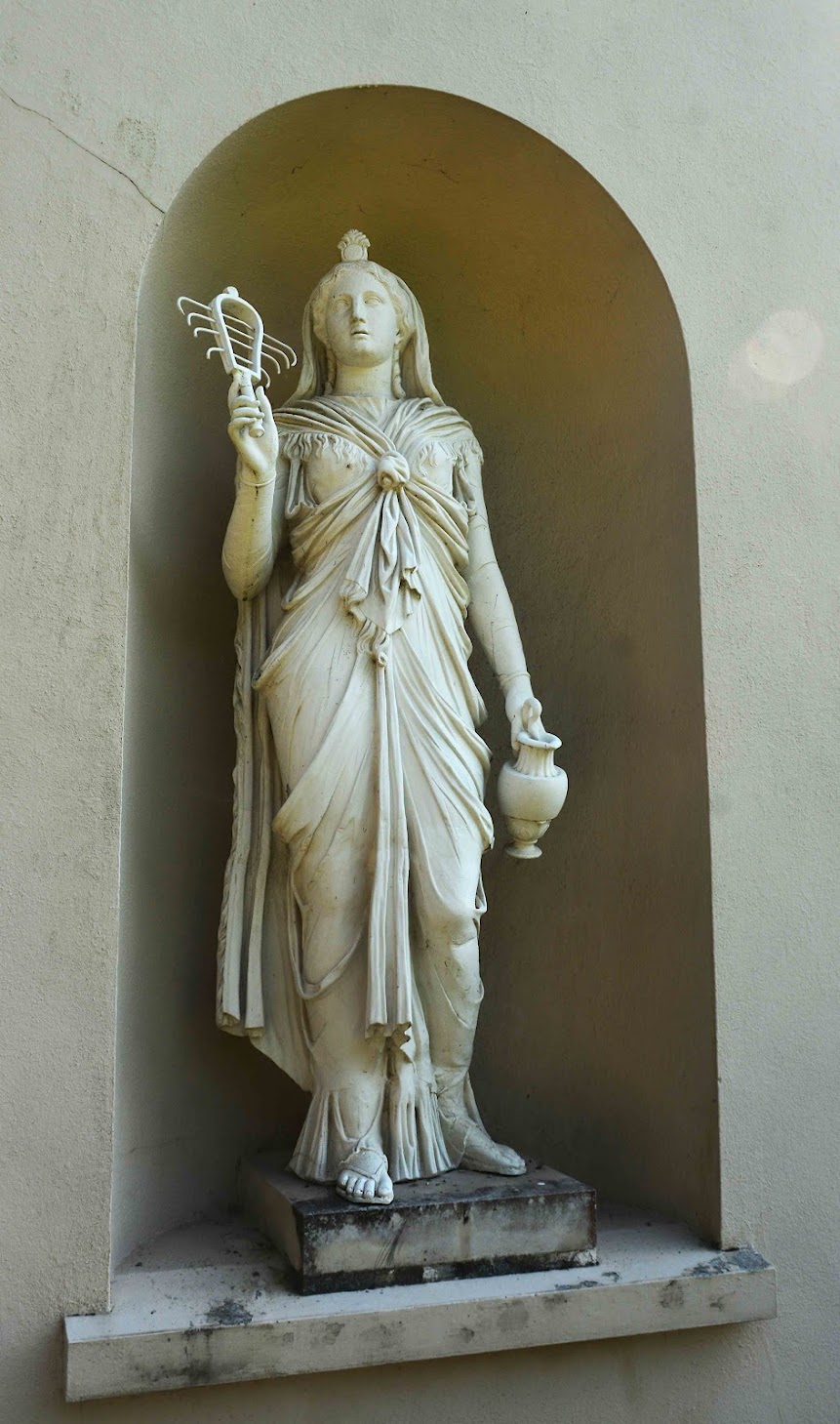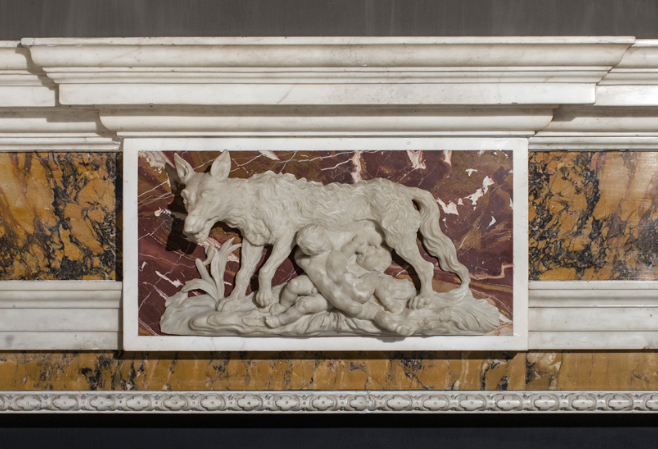Some notes and images for comparison.
The Photographs at Saltram taken by the author.
see - Saltram House: The Evolution of an Eighteenth-Century Country Estate Thesis by Katherine R Norley, 2020.
https://pure.plymouth.ac.uk/ws/portalfiles/portal/38443828/2020norley10328637resm_edited.pdf
The Lead Statue of the Capitoline Antinous.
Height 175 cms.
in the alcoves on the West front of the house.
There is no documentation for the purchase of the four statues but they were at Saltram by 1760.
Brettingham's Rome Account Book, - his ledger of statues dealt, casts made, bought and sold when he was in Italy, shows that in 1754 he commissioned a mould of the 'Antinous di Capidoglio' from which the Kedleston cast was taken (Kenworthy-Browne 1983, p. 99).
Two years earlier, in October
1752, he had also purchased a plaster cast of the statue, along with a cast of
Albani's Apollo, from the sculptor Pietro Bracci (1700-73) who was responsible
for restoring the antique Antinous' left arm and leg (Kenworthy-Browne 1983, p.
68). That cast is most likely the one at Holkham.
The Apollo Belvedere was one of twelve moulds of antique
statues Brettingham commissioned, at considerable trouble and expense, owed to
its enormous popularity (Kenworthy-Browne 1983: pp. 80, 99, 100). In
Brettingham's Rome Account Book, his ledger of statues dealt, casts made,
bought and sold when he was in Italy, records for 1754 show that moulds of 'ye
Meleager di Pichini' were acquired along with its pendant, 'ye Apollo di
Belveder' (Kenworthy-Browne 1983, p.99).
Literature -
Kenworthy-Browne 1983: John Kenworthy-Browne, 'Matthew
Brettingham's Rome Account Book 1747-1754', The Volume of the Walpole Society,
vol.49 (1983), pp.37-132, pp. 80, 99, 100.
Kenworthy-Browne 1993: John Kenworthy-Browne, ‘Designing
around the statues. Matthew Brettingham’s casts at Kedleston’, Apollo, April
1993, pp.248-252
It appears to retain much of its original bronzing.
Height inclusive of base 71 cm.
Base height x width x depth 2 cm x 33.7 cm x 9.1 cm.
...............
The Plaster Bust of Antinous formerly at Uppark.
One of six plaster busts, by John Cheere and ordered by Sir Matthew Fetherstonhaugh in 1759.
It has the typical socle used by John Cheere.
Sir Matthew's
a/c book May 1759 'Paid Mr. Chase for Busts £7.12'. (NT/UPP/SC/1b, c, d and
LOAN/UPP/SC/1e and f are others, all destroyed in the fire at Uppark on 30th
August 1989).
https://www.nationaltrustcollections.org.uk/object/138373.1
.......................
The Lydiard House Plaster bust of Antinous.
sizes - H 60 x W 40 x D 30 cm.
Again it has the typical socle used by John Cheere.
They say supplied in 1743?
This one of a group of busts and urns supplied to Lydiard Park
Image here from art uk website -
....................................
Priestess of Isis after the Antique.
Antique original found in Villa of Hadrian, Tivoli, now in Capitoline Museum, Rome.
This example made by John
Cheere, 1765-66, from Matthew Brettingham junior's moulds.
Another version of this statue in plaster is in the Pantheon at Stourhead, Wilts.
https://www.nationaltrustcollections.org.uk/object/562916
There is a plaster version at Kedleston.
Nathaniel Curzon (1726-1804) acquired his cast from Matthew Brettingham (1725-1803), an architect who primarily dealt in antiquities and casts for the British aristocracy.
The cast is listed as 'Priestess of Isis' in Curzon's manuscript 'List of Statues that I have' (c.1760) and again in a list inscribed on the verso, under 'Saloon Statues' (MS, Kedleston Archive). The statue was initially installed in the Saloon (see 'Catalogue of the pictures, statues, &c. at Kedleston', 1758, Saloon, p. 9), but by c. 1788-89, when the Saloon was converted into a ballroom, it had been moved to the Great Staircase, where it stands today (see 'Catalogue', 1769, Great Staircase, p.22, annotated copy in the Getty Research Institute, annotations date to c. 1788-9.). No receipts have been found for this cast.
During his seven-year stint in Rome (1747-54) Matthew Brettingham not only dealt in casts and antiquities - furnishing the Earl of Leicester, for example, with casts and marble statues for Holkham - but also commissioned actual moulds to be taken from famous Roman statues. The idea being that casts could then be made to order when he returned to London.
The Capitoline Isis was one of twelve moulds of antique statues Brettingham commissioned.
In Brettingham's Rome Account Book, his
ledger of statues dealt, casts made, bought and sold when he was in Italy, the
records for 14 December 1753 show that a 'Mould of ye Vestal Virgin at ye
Capital' was packed and shipped from Leghorn and that in 1754 further moulds
'of ye Vestal Virgin or Priestess of Isis' were produced (Kenworthy-Browne 1983,
pp. 79, 99, 100).
The casts were not the success Brettingham hoped. Despite bringing back to London an Italian craftsman, Bartolomeo Mattevali specifically for the job of casting from them, few actually sold.
There are only two surviving Brettingham casts of the Capitoline Isis, one of which is at Kedleston, the other at Holkham.
Literature -
Kenworthy-Browne 1983: John Kenworthy-Browne, 'Matthew
Brettingham's Rome Account Book 1747-1754', The Volume of the Walpole Society,
vol.49 (1983), pp.37-132, pp. 79, 99, 100.
Kenworthy-Browne 1993: John Kenworthy-Browne, ‘Designing
around the statues. Matthew Brettingham’s casts at Kedleston’, Apollo, April
1993, pp.248-252
The later versions of the Priestess of Isis at Stourhead and Croome Court
(along with the statue of Flora now with Los Angeles County Museum of Art) were supplied by John Cheere.
.......................................
The Plaster Statues at Croome Court -
Ten plaster statues by John Cheere were set within the niches along the north, south and east walls. These were: Camillus, Flora, Ganymede, Priestess of Isis, Vestal Virgin, Urania, The Medici Apollo, Mercury, Dancing Faun and the Medici Venus - Cheere’s bill itemises them as costing between 6 and 10 guineas each, plus the iron cramps, strong cases and hay for packing during transport
On the north wall was the Medici Apollo and Camillus/Urania. On the East wall to the left of the chimneypiece were: Camillus/Urania, Priestess of Isis and Ganymede. On the East wall to the right of the chimneypiece were: Medici Venus, Capitoline Flora ( now also in the Los Angeles County Museum) and Medici Mercury. On the south wall were the Dancing Faun and Vestal Virgin.
If my memory serves some of them were auctioned by Aldridges of Bath in the late 1970's early 1980's.
For much more on Croome see -
http://www.933.me.uk/croome/Croome%20Conservation%20Management%20and%20Maintenance%20Plan.pdf
The John Cheere lead Statues at Stourhead supplied 1765/6.
Vesta Vesta/Vestal Virgin,1765–66, lead, 1600 mm (height) west front, Stourhead; National Trust inventory no.562884);
Ceres 1765–66, lead, main entrance, stourhead); minerva
Minerva, 1765–66, lead, main entrance.
Pomona, Urania, 1765–66, lead, 1750 mm , west front, stourhead; national trust inventory no. 562883);
and Bacchus (‘with a stump with grapes & vine leaves’1765–66, 1580 mm (height), Pantheon exterior,
no. 562879)
Vestal Virgin by John Cheere (1709 – London 1787).
Height approx. 175 cms.
Copied from an antique statue formerly at Versailles, now in the Louvre.
Engraving published in reverse by Simon Thomassin (1694), pl.9.
A version was supplied by John Cheere, 1760s, for the Temple of Apollo at Stourhead and removed to West Garden 1903-4.

..................
Mercury.
Size approx. 160 cms.
c. 1765/66.
The Lead statue of Mercury, after the antique, supplied by John Cheere. It is a copy after an Antique marble in Uffizi Gallery, Florence (Haskell and Penny 1981, no.61, p.266) which was first recorded in 1536 when it was in the statue court of the Belvedere and by 1568 it was in the Palazzo Pitti and by 1734 in the Uffizi, but could be after bronze copy ex-Farnese collection in Naples (now in Louvre);
There are plaster versions at Kenwood (ex Croome), Wentworth Woodhouse, Hagley Hall and Holkham Hall.
Matthew Brettingham the Younger had a mould taken from marble Farnese statue, recorded in 1773).
At some point the Brettingham Moulds passed to John Cheere.
There is another version in lead at Southill Park. Bedfordshire.
Image courtesy Conway Library website (below).
A related although quite different lead version is at Stourhead and was supplied by Cheere for the Temple of Apollo, 1765-66 and was possibly taken from versions by Barthélemy de Melo for Versailles in 1684/5.
Removed to West Garden 1903-4. (info here Nat Trust website and needs to be verified).
A Gilded Plaster version of this statue is at Syon House. Middex.
.....................
The Pair of Lead Sphinx at Saltram.
One of a pair of 18th century lead sphinxes mounted in front of the South Entrance to the Mansion House and subsequently moved to the Orangery c.1820 and by NT to outside the Garden Room.
1210 x 560 mm
Photographed by the author
This pair of Sphinx replicate the four at Castle Hill.
All these sphinx derive from the same mould.
The Castle Hill Sphinx.
One of four Sphinx at Castle Hill. Devon.
All four were cast from the same mould.
Photographed by the author July 2025.
Sir Hugh Fortescue (created Lord Clinton in 1721 and Earl of Clinton and Lord Fortescue in 1746), a leading Whig politician, inherited Castle Hill in 1719.
A programme of improvement, with a concentrated period of activity in the early 1730s coinciding with his resignation from political office included the remodelling of both house and grounds.
A new Palladian
mansion was designed by Lord Burlington (1694-1753) with advice from the ninth
Earl of Pembroke (1693-1749). The extent of Earl Clinton's landscape is
recorded on field surveys (1763 and 1765), and views by John Wootton (about
1735-1740) and John Lange (1741).
.................
The Chiswick House Sphinx.
Casts of this sphinx were taken by Messrs Rupert Harris to replace the sphinx originally on the gate piers and removed to Green Park in 1897 to celebrate Queen Victoria's Diamond Jubilee.
The Rupert Harris casts have now replaced the sphinx on the gate piers
.....................
For more works of John Cheere with the National Trust see -
.............................
of tangential interest -
A Chimneypiece at Saltram.
Thomas Carter.
The Carter workshop was located at the Hyde Park Corner end of what is now Piccadilly
In the 1740s the workshop of Thomas Carter began to specialise increasingly in chimneypieces. These were often elaborate, incorporating polychrome marbles, reliefs of literary subjects, classically-derived telamonic figures and carving of the highest quality.
For the Great Apartments at Holkham Hall, Carter and another London neighbour, Joseph Pickford, provided architectural chimneypieces ‘for the most part copied from Inigo Jones’s works’ (Brettingham 1773, ix).
In other rooms Carter used colourful Sicilian Jaspar and Siena yellow marbles as grounds for reliefs of subjects after the Antique, taken from engravings in Montfaucon’s influential L’Antiquité Expliquée, 1719.
Sir Matthew Featherstonehaugh of Uppark paid Carter nearly £1000 between 1747 and 1756 for fireplaces decorated with caryatid figures of classical philosophers and tablets representing Androcles and the Lion and Romulus and Remus (the later relief employed also at Saltram and perhaps elsewhere)
...........................
Another Carter Chimneypiece with dealers Chesney's.
Mid 18th Century.
Statuary Marble with Convent Sienna and Sicilian Jaspar veneers.
width 197.5 cm.
No provenance given
From a series of six plates, etched by Hollar after drawings
by Giulio Romano from the collection of Nicolas Lanier, designs for stucco
medallions at the Palazzo Te in Mantua.

































.jpg)




No comments:
Post a Comment